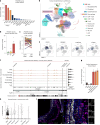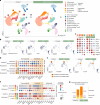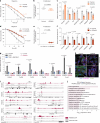PRDM16 regulates smooth muscle cell identity and atherosclerotic plaque composition
- PMID: 41107595
- PMCID: PMC12611775
- DOI: 10.1038/s44161-025-00737-8
PRDM16 regulates smooth muscle cell identity and atherosclerotic plaque composition
Abstract
Vascular smooth muscle cells (SMCs) undergo phenotype switching to acquire various fates in response to pathological stimuli. Among these, 'synthetic' SMCs-defined by migration, proliferation and extracellular matrix production-accumulate in atherosclerotic lesions and contribute to fibrous cap formation. The mechanisms driving this synthetic transition remain unclear. Here we identify PRDM16, a gene linked to cardiovascular disease, as a critical transcriptional repressor of the synthetic SMC phenotype. PRDM16 expression declined during SMC modulation, and its deletion in mice induced a synthetic program across all SMC subtypes even without pathological stimuli. Under atherogenic conditions, PRDM16 deficiency resulted in the formation of fibroproliferative plaques with more synthetic SMCs and fewer foam cells. Conversely, enforced PRDM16 expression suppressed SMC migration, proliferation and fibrosis. Mechanistically, PRDM16 occupied chromatin and suppressed activating marks at synthetic loci. These findings establish PRDM16 as a gatekeeper of SMC fate and reveal its role in shaping atherosclerotic plaque composition.
© 2025. The Author(s).
Conflict of interest statement
Competing interests: The authors declare no competing interests.
Figures














References
-
- Libby, P. et al. Atherosclerosis. Nat Rev Dis Primers5, 56 (2019). - PubMed
-
- Libby, P., Ridker, P. M. & Hansson, G. K. Progress and challenges in translating the biology of atherosclerosis. Nature473, 317–325 (2011). - PubMed
-
- Rader, D. J. & Daugherty, A. Translating molecular discoveries into new therapies for atherosclerosis. Nature451, 904–913 (2008). - PubMed
MeSH terms
Substances
Grants and funding
- DK123356/U.S. Department of Health & Human Services | NIH | National Institute of Diabetes and Digestive and Kidney Diseases (National Institute of Diabetes & Digestive & Kidney Diseases)
- DK126194/U.S. Department of Health & Human Services | NIH | National Institute of Diabetes and Digestive and Kidney Diseases (National Institute of Diabetes & Digestive & Kidney Diseases)
- DK120982/U.S. Department of Health & Human Services | NIH | National Institute of Diabetes and Digestive and Kidney Diseases (National Institute of Diabetes & Digestive & Kidney Diseases)
- 40-45200-98-21118/ZonMw (Netherlands Organisation for Health Research and Development)
- R01HL150359/U.S. Department of Health & Human Services | NIH | National Heart, Lung, and Blood Institute (NHLBI)
- R01HL166916/U.S. Department of Health & Human Services | NIH | National Heart, Lung, and Blood Institute (NHLBI)
- R01HL169766/U.S. Department of Health & Human Services | NIH | National Heart, Lung, and Blood Institute (NHLBI)
- R01HL164577/U.S. Department of Health & Human Services | NIH | National Heart, Lung, and Blood Institute (NHLBI)
- R01HL148239/U.S. Department of Health & Human Services | NIH | National Heart, Lung, and Blood Institute (NHLBI)
LinkOut - more resources
Full Text Sources
Medical
Miscellaneous
